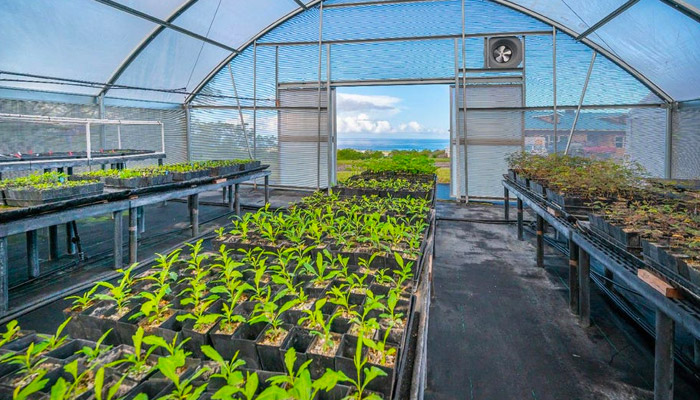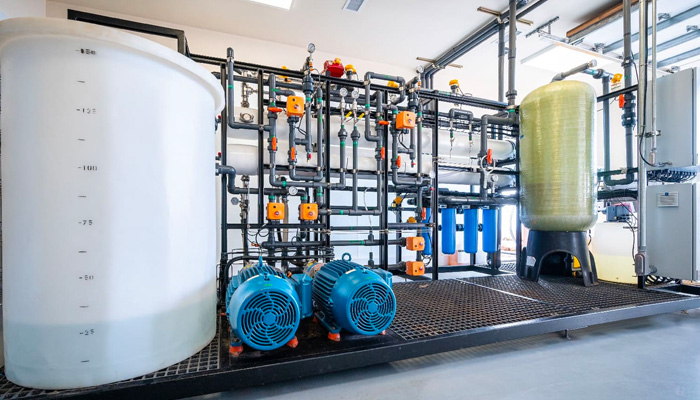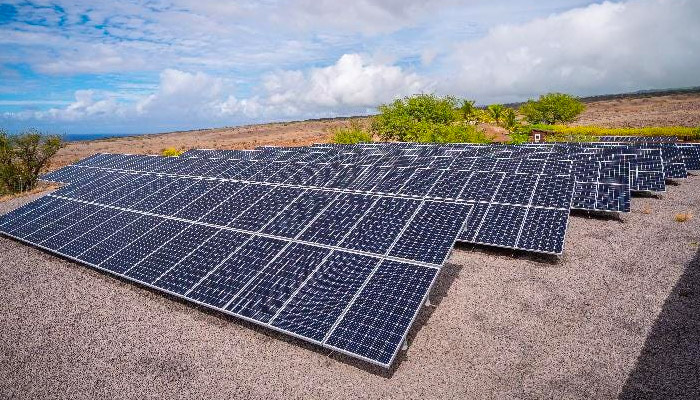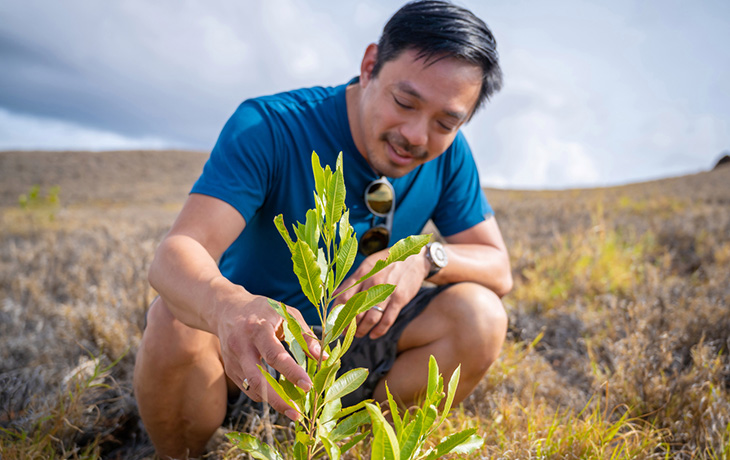The startup Terraformation recently raised $30M as part of its quest to solve the climate crisis by rapidly reforesting 3 billion acres — which is more land than the entire US!
Founder Yishan Wong, the former CEO of Reddit and an early employee at Facebook and PayPal, talked with us about his new project and what he’s learned that could be helpful for you and your community as we all try to prevent our planet from dying.
Quick intro clip on Terraformation:
Full interview below. My favorite parts are when Yishan explains the importance of community, something modern preppers have been beating the drum about for years.
Yishan and myself are two examples of Silicon Valley techie entrepreneurs who are trying to apply the lessons we’ve learned in the Valley to the existential problems we face as a species — in Yishan’s case, figuring out how to plant the trillion trees needed in the next decade to help prevent the worst-case climate crisis scenarios by removing harmful carbon from the air.
This goes hand-in-hand with why a large percentage of Valley leaders are preppers. I’m doing some media about this topic soon and will write more about it here, but the punchline is that people who succeed in the Valley are unusually good at understanding big gnarly problems, figuring out how to solve them at scale, and then rapidly executing with small budgets. It’s more about process and culture than it is about programming code.
In Yishan and Terraformation’s case, you’ll see how reaching reforestation goals is less about a fancy new technological innovation and more about innovating the processes and organization that results in planting. For example, think about what SpaceX has been able to do for space tech compared to the slower government pace beforehand. Sure, SpaceX came up with new tech and products, but their real secret sauce is knowing how to cut through the b.s. and get things done.
Besides the general goal of planting trees, Terraformation is also developing a seed bank in a shipping container and a 1,200 square foot nursery kit.
If you’re fired up about Terraformation, you can invest directly in the company or check out their remote job openings.
TP: The focus on planting a lot of trees to help offset climate change has existed for a while. What wasn’t working before? Was it simply not done largely and quickly enough to make the difference we need?
Yishan: Two things. First, for a long time, “reforestation” was done incorrectly.
Monoculture plantations, predicated on the idea that you should just plant a maximum number of the fastest-growing tree species, resulted in a failure to establish resilient native ecosystems. Meaning the trees just eventually died. Or, poorly-designed policies that incentivized cutting down old-growth forest to, again, plant monoculture plantations.
As early as 1991, there was a paper talking about the potential for reforestation as a solution against (what was called at the time) “the carbon dioxide problem.” It was around then that tree plantations started, but it took a decade or so and many failures to realize all the ways you can do forest restoration incorrectly.
Now, 30 years later, the world has learned a lot of bitter lessons, but we do now know how to restore forests:
- It requires a restoration using native species which are adapted to the local environment, thus recreating self-sustaining resilient ecosystems.
- It has to be done in cooperation with local communities, who are the true owners (de facto if not legally) of the land.
Second: The scale of the problem is simply so huge, and no organization has even reached a fraction of the total amount needed. We need something on the order of 3 billion acres of newly restored forests, which is very roughly 1 trillion trees. The largest ambition in the past was a “mere” billion trees, and the largest reforestation programs have only covered millions of acres. Those are very large numbers, but they’re still only 0.1% of the total problem.
So it’s a combination of both: we were (collectively) learning how to do it correctly, and there’s a lot of it that needs to be done, and we’ve just gotten started.
How are you able to solve rapid reforestation? Is there something you’re contrarian-but-correct about? Besides the actual number of trees grown, what do you hope is the biggest impact of your project, eg. is there some technical insight you’ve figured out or are figuring out, such as seed delivery at scale?
Well, individually speaking, we don’t plant trees any faster than anyone else. What we do is look at the throughput of the entire system and realize that tree-planting is one of the most parallelizable activities on the planet.
Trees take their own time to mature: you plant it, and it will mature over the next 10-20 years. There is no way to rush that. So we have to figure out how to do all the “human activity” parts as fast as we can, all the things that we do before that final point where the tree goes into the ground.
Traditional growing operations and nurseries obviously understand this: they grow thousands of plants simultaneously. It obviously doesn’t have to stop there. If we can scale up the world’s supply chain and infrastructure, we can literally begin the growing of a trillion trees worldwide all within a decade.
I think the thing we’re “contrarian but correct” about is that we honestly believe massive global reforestation is absolutely the best carbon capture solution we have, and that we should begin implementing it at the maximum possible scale immediately.
To fight climate change, there are two key things we have to do:
- Reduce emissions
- Remove existing carbon
Many people are working on #1, but compared to the efforts being made there, I don’t think there is nearly as much truly deep thinking about #2. It’s often just a theoretical exercise to most people, which is why a lot of the proposals are fanciful.
If you look at the alternatives in a hard-headed, “Ok, I want something I can actually do, right now, and it will scale, and it will work, with minimal risk, because we don’t have much time left,” the obvious answer is — by nearly an order of magnitude — massive reforestation.
For a while, the main argument against mass reforestation is that there wasn’t enough land with natural rainfall to make it work. What was particularly irrational about that argument is supposedly there was only enough land to solve about 30% of the total problem. Which resulted in many people saying, “Ok, then forget it,” when the rational answer should’ve been, “Oh, you can solve 30% of climate change? Do it!”
I mean, very otherwise-intelligent people reacted like that. Bill Gates, of all people, is one of them!
Well, we were able to come up with a solution to that: you can regreen deserts, in many cases deserts that were even (in ancient times) once rainforests. That’s been shown to work in several smaller-scale projects, and the limiting factor is freshwater availability — while there is also a global freshwater shortage problem. Where can you get more freshwater?
It turns out that in 2018, the cost of solar power dropped below that of fossil fuels, which unlocked the ability to produce freshwater from seawater using reverse osmosis desalination. Desal had previously only been economic using cheap fossil fuels, but using fossil fuels at such a large scale was untenable. With cheap solar, it becomes feasible to desalinate arbitrarily large amounts of freshwater, enough to regreen all the deserts we would need.
Obviously, this is still a gigantic manufacturing and supply chain problem, but it charts a route for us to produce enough water to irrigate enough forests that would be sufficient to offset all or most human emissions. And it does so without requiring the development of new technology: solar power and desalination are both decades-old, proven technologies, and the “innovation” is that the costs finally reached a point where they could be affordably deployed at massive scale to solve this problem.
Like any good startup, you started with smaller experiments. What were you surprised by from the first test site you developed in Hawaii?
Frankly, how fast life began to return as soon as there was more water.
Even before we had the full-scale irrigation systems established, just the fact that we were splashing water around as a result of the construction (e.g. sometimes we’d spray down the roads to keep the dust down, or we had smaller green areas), many native plants, as well as bird and insect species were spotted returning in the first year after we began construction.
It’s really true that “life finds a way.” The earth is constantly trying to regenerate itself, and if we can remove the little bottlenecks that might be holding it back in an area, it’s more than likely that it will “spring back” at surprising speed.
Clip of the HI test site:
What have you learned about planting and growing trees that could be useful to individual people with normal resources?
It’s really a very “partial credit” and “do it at any scale” type of activity.
You don’t have to do some huge plan, you don’t have to plan a million trees. It’s about quality. If you plant one tree, and you pick the right species and you plant it in the right place and take good care of it, and it matures into a healthy adult tree, you have done something beneficial for the world and future generations.
It’s also important to realize that by doing something, you are likely to inspire others to do the same thing. We are a very memetic species. Just seeing someone do something makes it clear that it’s possible, and seeing lots of people do something makes it much more popular. So just do one, and convince your friend to do it too, and then together start convincing more people.
You don’t have to do a million. You just have to do something, every day.
How important is it to pick the “right” tree species? For example, we’ve already discussed how past reforestation efforts have missed the mark because they focus on planting commercially-valuable trees instead of native species that are better for the ecology.
They should be native species. That’s not too hard, because in every location there are always many native species to pick from. Planting native species enables you to create a forest ecosystem around the tree — that’s the key.
[John jumping in here to say that the local “Extension” campus of your state university system is a great online source for learning about what species are native to your area. It’s often surprising.]
Many people miss the fact that trees exist as part of a complex ecosystem. The byproducts of a tree support other species: insects, bacteria, fungi, birds, other animals, other smaller plants, etc. Native tree species support an order of magnitude more species than non-native species, because a native tree has co-evolved over millennia with the other life in that location. It’s not an authenticity or anti-colonialist argument. It’s literally about how much other life the tree is able to support.
All life is carbon, and what you’re trying to do is not optimize for the biomass of the tree, but the biomass of that entire ecosystem. You want to support as much life around the tree, because that’s the true deep long-term carbon sink.
If you just optimize for the tree, then when the tree dies, the carbon inside it is re-released. That’s why people make arguments about tree carbon capture being “impermanent.”
But if you optimize for supporting a rich ecosystem, then when the tree dies, the re-released carbon is taken up by other plants, or even children of the original tree. So the ecosystem cycles the carbon back into itself continually, and successful forest ecosystems can be hundreds of thousands or even millions of years old — that’s very permanent deep carbon storage.

Many forests have been cut down for agriculture. Is there a sustainable way to integrate trees into agriculture, like permaculture and silvopasture? What’s your take on food forests and plant guilds?
There definitely is, and in fact it’s one of the most intriguing possibilities especially when it comes to regreening land.
You can grow a forest of native hardwoods, and then underneath the shade of that tree you can practice agriculture (agroforestry), or permaculture, or silvopasture, or some combination.
Sometimes people worry that reforestation would be in competition with agriculture. But you can literally take desert land and begin to regreen it with a native hardwood canopy, and then that land becomes agriculturally productive. The specifics depend a lot on the species involved and involvement of the local community, but it is an extremely promising area for both forest restoration and economic development.
Based on your first rounds of planting, have you changed your criteria for what kind of land you do or don’t want to revitalize?
That’s a pretty interesting question! I’m really not sure.
There’s definitely land that’s “easier” for certain reasons (e.g. rich soil, good rainfall). On the other hand, it can be a lot of fun to come up with creative solutions for more challenging land. It feels great to be able to bring life to a place that isn’t “supposed” to be able to support life. It feels like the earth thanks you, just by thriving when you do it.
I suppose one big thing is the people who are around. People talk a lot about how reforestation has to be done “along with the local communities.” That’s just a specific instance of “who’s your neighbor?” Having a neighbor who is into it, or a nearby community who’s into it, makes a big difference. There is something primal and awesome about a bunch of people working together to revitalize land.
What would you recommend to someone in the TP community who owns land, is worried about climate change, and wants to take steps to make their land better?
You should figure out what your land is trying to do. It’s less about what you do “to” your land, but what you do “with” your land.
Invest in understanding the native species that are there, the current conditions, the history of the land, and how it was different in the past. What used to be there? Did there used to be more water? Are there plants or animals here now that didn’t used to be, and are they eating certain things or causing other things to happen?
Then you can sort of figure out what changes will make the most difference, what actions you can take. If you can figure out the right ones, the land will thank you by bouncing back with more life. And all life is carbon, so you’re doing your part by pulling CO2 out of the air the more life you enable to return.
Remember that it’s not always about trees or forests — e.g. some prairie grasslands have species of prairie grass that have super ultra deep extensive root systems that sequester most of their biomass underground (and hold soil together).
If you had some extra acreage around your own homestead, would you rather let it “go wild” without intervention, or does putting active effort into it pay dividends?
I’m actually a fan of active and conscious stewardship. We are humans, we are intelligent, and we can think about how our actions can benefit the world around us, and take an active role. Some people have fear or guilt around this, like we’ve messed stuff up. Sure, that may be the case, but the important thing there is not to be scared, but to learn how and why you messed up, and then do things differently and keep learning.
Personally, I would do a blend: put “just enough effort” into it, because sometimes “completely wild” can go out of balance, but you don’t want to over-control either. Just be aware, try to guide things a little bit, and then let things grow.
As we think about the future, we wonder what role desalinization will play as freshwater sources become scarce. You desalinate nearby seawater to hydrate your young trees in Hawaii. How’d that go? What’s your take on the state of that tech/market?
I think desalination will literally save the world and ultimately lead to a new age of prosperity. I’m serious. It’s that much of a game-changer.
But, it’s not actually so much of an individual thing. It’s a community, cooperative thing. We have to think of it in terms of entire societies.


If you think of the Earth’s water cycle, it’s (very roughly) like: warm air condenses over the ocean, moves inland, cools as it approaches the mountains, turns into rain in the mountains (or snow/ice, which melts later), runs down the mountains into lakes, streams, aquifers, and ultimately back down to the coast.
Along the way, people use the water. We spend huge amounts of time and money diverting that water for our uses. The ironic thing is that most human beings live near the coast, yet we cannot drink seawater — we cannot drink any of that huge amount of water we’re next to. Instead, we spend all this time and money and energy moving water down from the mountains all the way down to the coast. It has been like this since the dawn of civilization. Roman aqueducts were basically this.
Now suddenly we have the ability to take seawater and turn it into freshwater, and we can do it using cheap solar power, so it doesn’t result in fossil emissions. This releases us from an economic straitjacket that we’ve been in for all of history.
Now the majority of humans who live near the coast can produce their own freshwater and move it a minimal distance to the point of usage, while the humans who live inland can just keep the mountain runoff and not spend all this money and effort flowing down to the coast. Everyone wins, and we collectively save money. We also recharge all the inland aquifers, reversing the trend towards desertification that we’re seeing in many places.
I was just talking to our community association here in Waimea, on the Big Island. We’re up in the mountains here, and all our water comes from mountain runoff. But the Waimea county water system also serves the resorts down by the shore. I gave a little presentation to the association about what we were doing with solar desalination, and I explained that our water infrastructure is responsible for sending all this water from the mountains down to these resorts. But with solar desalination, all those resorts can just make their own freshwater on-site, much closer, without needing to pipe it all the way down like that. And then we all (collectively) save money on moving all that water, and everyone has twice as much water.
So it’s less about whether or how it’s practical for an individual land owner. If you don’t live near the shore, getting access to seawater is hard. You shouldn’t use desalination then, you should use mountain runoff, or rain catchment, or whatever fits your area. But, because ultimately we all share water, and we have to build these elaborate systems to distribute water and figure out how to pay each other for it, if we work together to find a second source of water — solar desalination — and it just so happens to work best at the exact opposite end as the source of the first one (mountains), then we all benefit because now the whole system is more efficient.
Is it feasible for an individual to rely on desalinating seawater? If not today, when will this become as cheap and easy as solar has become?
As an individual, if you have a source of seawater (coastal or brackish), you can do it today. It will cost about $10,000 to purchase the solar, desal, and plumbing/storage infrastructure to supply a household with water using solar desal.
That cost will drop by around 50% in about 5 years.
The main cost really is how much it costs you to get a source of seawater. If you’re literally on the shore, you just stick a pipe in the water (this is an oversimplification; you want to dig a shallow well near the shore so that the sediment helps filter out the marine life). If you go with this setup, don’t dump your brine effluent on the shore, you will kill the marine life. There are a number of straightforward methods for safe and responsible disposal of your brine, just don’t dump it on the shore, please!
If you are a little bit further inland, you will need to dig a well to reach brackish water (infiltrated from the sea), but the cost of digging a well is proportional to how deep you’re trying to go, so it becomes uneconomical as you move inland.
Any other insights to share for individuals worried about the climate future and wondering how they can make their own home/community more resilient?
You know, I hate to give you what will sound like a wishy-washy answer, but it depends on the community. Every place is different, and climate change is going to affect every location in different ways. Some places are going to get wetter, some drier, some will have floods, some will have storms. Some places will get very hot, some will get very cold, some will get both (which sucks a lot). Some places may have huge species die-offs, agricultural disasters, and infrastructure collapse.
And another problem is that the rate of change is going to go up. It’s not just that things will change to a new normal and then settle. The new normal is a constant state of change. If we knew, for example, that New York City was going to flood and become like Venice, we could theoretically handle that. But the problem is the constant changing and unpredictability, which makes it hard to prepare for and react to events. You could have major floods one year, then not enough water to feed people the next.
If I had to say one thing then, since the rate of change will be so high and things will be ultimately unpredictable, I’d say you should focus on the strength of your community. Go out and build community. Make sure you are friends with your neighbors. Do your part to stop this cultural polarization that’s happening. We are all different, yes, we all have different life experiences and beliefs, but we all have common interests. What we should focus on are our common interests, and then let each other just be different.
Because what ensures human survival the most when things get bad is how well humans work together. I am a firm believer in humans working together. The number of incredibly difficult things humans have collectively overcome is staggering, and our species’ strength has always been in how effective we are when we work together. And make no mistake, we are a diverse bunch. We are very different. But when we are friends because we recognize our common interests, that is the best way to overcome disaster. A solid community of human beings is unstoppable.
Is there a specific ask people should have of their politicians, such as a law or cause to support?
There’s so many, so I’ll boil it down to this: subsidies for trees, not oil.
There actually isn’t “one law” that subsidizes fossil fuels — advantages for fossil fuels are actually woven into the structure of our legal code. So the general ask is to remove and reduce laws and subsidies that advantage fossil fuel development, and pass laws that advantage and subsidize the conservation, growth, and intelligent management of forests.
Besides rapid reforestation, what are the other highest-leverage things that need to be done to save the planet that more people like you / who aspire to be like you should pay attention to?
I think that advancements in the following areas are most likely to have the biggest impact on solving our climate problem faster:
- Energy storage efficiency
- Solar collection efficiency
- Nuclear technology
- Water purification / desalination efficiency
- Agricultural innovations and soil generation techniques
- Hydrogen production and distribution improvements
- Avoided deforestation and improved forest management
I’m probably missing a bunch of things but those are the first ones that come to mind.
Besides this, I have a message for the young people. I don’t know how many young people reading this are preppers, but just in case:
You have lived your entire lives under the specter of climate change. Your generation grew up in a time of fear and terror. You have been told that your world is doomed and that there is nothing you can do about it, that you have no power, that your future cannot be changed.
I am here to tell you that all of that is false, that this world belongs to you, and you have all the power to shape it to be as you dream it should be.
In fact, your generation is more powerful than any generation of human beings in history. The tools and technology you command today make you nearly godlike compared to your ancestors. You are more well-networked to each other — all over the world — than any generation in the past, and your ability to act collectively is greater than any that human history has ever seen.
The people who run the world today, who want to make you feel powerless — they don’t know what they’re doing. The systems and great institutions of the world that were built by their parents and grandparents are breaking down, and they have no idea what to do. I know this, because I have talked to those people.
Every day that goes by, they grow older and weaker. They are fearful. But you do not need to be. Every day that goes by, you grow stronger and wiser. Your experience and capabilities multiply, while theirs diminishes.
Understand the strength you have, dare to remake this world, and you will succeed.
You don’t have to join me. All you have to do is join each other. Do not be divided: find your common ground and lift each other up, and together your generation will create the future you deserve.


You are reporting the comment """ by on